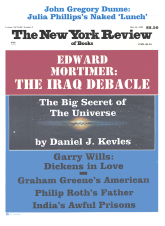In response to:
Supreme Suprematist from the January 17, 1991 issue
To the Editors:
“Supreme Suprematist” [NYR, January 17], John Golding’s tribute to Kazimir Malevich, derives in large part from the text of a lecture the author gave in Sydney in the 1970s (published in the March-April 1975 issue of Studio International [London]).
In the present article Mr. Golding assessed the exhibition Kazimir Malevich, 1878–1935 as “the most thoughtful and revealing survey of Malevich’s work to date.” Touching on the exhibition catalog in the last paragraph of his review, he commends 1) the invaluable new scholarship contained in the collaborative catalog entries, 2) the previously published chronology that has been revised and expanded, and 3) the list of thirty-four works by Malevich dispersed to Soviet museums from 1919 to 1921. Mr. Golding then abruptly dismisses the rest of the catalog as “a sad affair.”
It is important to note that this dismissal includes a revised essay by Dmitri Sarabianov, professor of art history and corresponding member, Academy of Sciences, USSR, as well as new translations of two autobiographical excerpts by Malevich (1923–1925 and 1933). The catalog also includes a substantial amount of previously unpublished material: an essay titled “Malevich and the Energy of Language” by John Bowlt, a specialist on the Russian avant-garde and professor of Slavic languages and literature, University of Southern California; an extended study of Malevich’s painting technique by Milda Vikturina and Alla Lukanova, senior research curators at the Tretiakov; and an excerpt from the artist’s essay “Futurism-Suprematism, 1921,” newly discovered and translated by John Bowlt who also prepared the bibliography of books and articles on Malevich published during the last decade.
Doesn’t Mr. Golding’s disdain for these significant contributions to the exhibition catalog suggest that the work of some of his distinguished Soviet and American colleagues has not been given careful, unbiased attention?
Jeanne D’Andrea
Los Angeles, California
John Golding replies:
I am sorry that I offended the editor of the catalog that accompanied the recent Malevich exhibition, but I still think that the catalog was not worthy of the exhibition.
Professor Sarabianov is a distinguished scholar but his essay on “Malevich and His Art, 1900–1930” contains little that is new; it demonstrates, too, that whereas Russia contributed so notably to the evolution of modern art earlier in this century, some contemporary Soviet art historians, however erudite, do not yet feel completely at home when writing about the period. John Bowlt’s piece on “Malevich and the Energy of Language” is interesting, but as its title suggests, it is not concerned with Malevich and it was not, I believe, written specifically for this publication. The study of Malevich’s technique is in some ways informative without perhaps telling us as much about his working methods as we would like to know. Whereas the technical analysis undertaken could clearly be useful, the conclusions drawn from it are not, and the interpretation of the results is therefore disappointingly inconclusive. Eight of the ten paintings analyzed were in the exhibition. The date ascribed to one of them (Catalog No. 2) is at least open to debate; the captions under the reproductions of two others (Catalog Nos. 30 and 31) have been reversed, causing considerable confusion. The 1910 date of Sisters (figure 62) has been seriously questioned by other scholars but no reference to the controversy is made here. (I eventually stopped counting the number of mistakes listed in the corrigenda to N. Avtonomova’s article.) The extract form Malevich’s essay “Futurism-Suprematism” runs to some two thousand words; an introductory note tells us that “in the interest of accessibility…an attempt has been made to clarify the more obscure passages of this extremely tense and complex treatise.” To judge from this fragment it would appear that this essay lacks on the one hand the excitement engendered by Malevich’s earlier pronouncements on Cubism and Futurism and on the other the greater objectivity he subsequently brought to his discussion of these movements.
I deliberately inserted a footnote to my 1975 article to indicate that I was drawing on my own early researches. If I have not substantially changed my ideas this is undoubtedly, in part at least, because surprisingly little of interest or substance on Malevich has been published in the intervening period. The catalog of this superb exhibition might have attempted to rectify this state of affairs; it failed to do so.
This Issue
May 16, 1991



